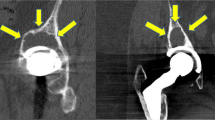Abstract
Purpose
The use of screws can enhance immediate cup fixation, but the influence of screw insertion on cup position has not previously been measured. The purpose of this study was to quantitatively evaluate the effect of intra-operative screw fixation on acetabular component alignment that has been inserted with the use of a navigation system.
Methods
We used a navigation system to measure cup alignment at the time of press-fit and after screw fixation in 144 hips undergoing total hip arthroplasty. We also compared those findings with factors measured from postoperative radiographs.
Results
The mean intra-operative change of cup position was 1.78° for inclination and 1.81° for anteversion. The intra-operative change of anteversion correlated with the number of screws. The intra-operative change of inclination also correlated with medial hip centre.
Conclusion
The insertion of screws can induce changes in cup alignment, especially when multiple screws are used or if a more medial hip centre is required for rigid acetabular fixation.


Similar content being viewed by others
References
Ryan JA, Jamali AA, Bargar WL (2010) Accuracy of computer navigation for acetabular component placement in THA. Clin Orthop Relat Res 468(1):169–177
Schmalzried TP, Harris WH (1992) The Harris-Galante porous-coated acetabular component with screw fixation. Radiographic analysis of eighty-three primary hip replacements at a minimum of five years. J Bone Joint Surg Am 74(8):1130–1139
Clohisy JC, Harris WH (1999) The Harris-Galante porous-coated acetabular component with screw fixation. An average ten-year follow-up study. J Bone Joint Surg Am 81(1):66–73
Meneghini RM, Stultz AD, Watson JS, Ziemba-Davis M, Buckley CA (2010) Does ischial screw fixation improve mechanical stability in revision total hip arthroplasty? J Arthroplasty 25(7):1157–1161
García-Rey E, García-Cimbrelo E, Cruz-Pardos A (2012) Cup press fit in uncemented THA depends on sex, acetabular shape, and surgical technique. Clin Orthop Relat Res 470(11):3014–3023
Hayashi S, Nishiyama T, Fujishiro T, Hashimoto S, Kanzaki N, Nishida K, Kurosaka M (2012) Obese patients may have more soft tissue impingement following primary total hip arthroplasty. Int Orthop 36(12):2419–2423
Hayashi S, Nishiyama T, Fujishiro T, Hashimoto S, Kanzaki N, Nishida K, Kuroda R, Kurosaka M (2013) Evaluation of the accuracy of femoral component orientation by the CT-based fluoro-matched navigation system. Int Orthop 37(6):1063–1068
Hayashi S, Nishiyama T, Fujishiro T, Hashimoto S, Kanzaki N, Nishida K, Kuroda R, Kurosaka M (2013) Excessive femoral offset does not affect the range of motion after total hip arthroplasty. Int Orthop 37(7):1233–1237
Sharp IK (1961) Acetabular dysplasia: the acetabular angle. J Bone Joint Surg Br 43(2):268–272
Spears IR, Pfleiderer M, Schneider E, Hille E, Morlock MM (2001) The effect of interfacial parameters on cup-bone relative micromotions. A finite element investigation. J Biomech 34(1):113–120
Hugate RR, Dickey ID, Chen Q, Wood CM, Sim FH, Rock MG (2009) Fixed-angle screws vs standard screws in acetabular prosthesis fixation: a cadaveric biomechanical study. J Arthroplasty 24(5):806–814
Hsu JT, Lai KA, Chen Q, Zobitz ME, Huang HL, An KN, Chang CH (2006) The relation between micromotion and screw fixation in acetabular cup. Comput Methods Programs Biomed 84(1):34–41
Hsu JT, Chang CH, An KN, Zobitz ME, Phimolsarnti R, Hugate RR, Lai KA (2007) Effects of screw eccentricity on the initial stability of the acetabular cup. Int Orthop 31(4):451–455
Kwong LM, O’Connor DO, Sedlacek RC, Krushell RJ, Maloney WJ, Harris WH (1994) A quantitative in vitro assessment of fit and screw fixation on the stability of a cementless hemispherical acetabular component. J Arthroplasty 9(2):163–170
Hsu JT, Chang CH, Huang HL, Zobitz ME, Chen WP, Lai KA, An KN (2007) The number of screws, bone quality, and friction coefficient affect acetabular cup stability. Med Eng Phys 29(10):1089–1095
Author information
Authors and Affiliations
Corresponding author
Rights and permissions
About this article
Cite this article
Fujishiro, T., Hayashi, S., Kanzaki, N. et al. Effect of screw fixation on acetabular component alignment change in total hip arthroplasty. International Orthopaedics (SICOT) 38, 1155–1158 (2014). https://doi.org/10.1007/s00264-013-2271-0
Received:
Accepted:
Published:
Issue Date:
DOI: https://doi.org/10.1007/s00264-013-2271-0




